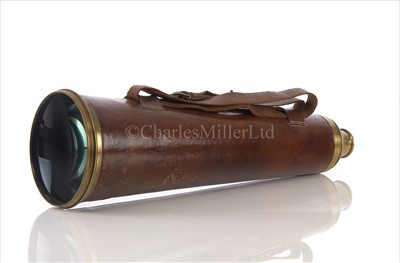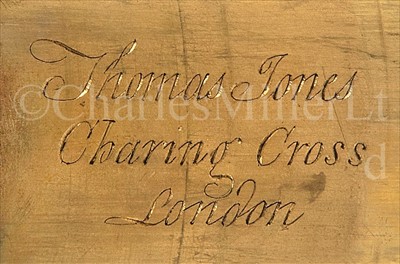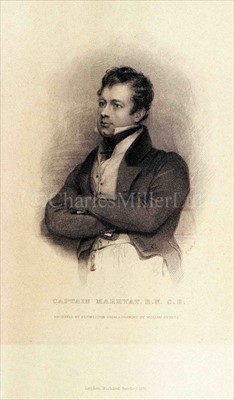27th Oct, 2010 12:00
Maritime and Scientific Models, Instruments & Art (Audacious)
72
[M] CAPTAIN MARRYAT'S TELESCOPE<br/>a rare model by...
CAPTAIN MARRYAT'S TELESCOPE
a rare model by Thomas Jones, London comprising a 5½in. objective lens with removable lens cap, tapering leather-covered tube with carry strap and single drawer with dust slide, signed Captain Marryat C.B. / Thomas Jones, Charing Cross, London -- 21in. (53.5cm.) high (closed)
Captain Frederick Marryat (1792-1848) joined the navy in 1806 and, although he missed all the big fleet actions, he enjoyed a lively naval career and seemed to take his lead from his first Commander, Lord Cochrane. By the close of the Napoleonic Wars, he had guarded Napoleon, assisted in several spirited frigate actions, survived serious fevers, saved five lives in action and had been promoted Commander. Despite this, he found fame initially for his signal code, first published in 1817. The Code of Signals for the Merchant Service became an international success going through no less than nineteen editions (not including foreign ones) through to 1879 and which was still used by some merchants until the 1890s. When he retired from the Navy (or rather hot-headedly resigned on the nominal grounds of 'private affairs') in 1830 he became a man of letters and it was in this part of his career that he became a highly popular author, spawning many famous works drawn from his own experiences: Newton Forster, Peter Simple, Jacob Faithful, Midshipman Easy, and Japhet came first to great acclaim. The last eight years of his life was devoted to children's stories including Masterman Ready, or, The Wreck of the Pacific (1841) and The Children of the New Forest (1847). He also colluded with Issac Cruickshank who wittily illustrated his Midshipman Ben Blockhead series which are duplicated often in modern references.
The instrument offered is a very rare form and the huge objective lens gives a bright and wide field of vision suited more to celestial navigation than signals. It is thought that only four others by Jones exist, one of which is in the national collection at Greenwich.
a rare model by Thomas Jones, London comprising a 5½in. objective lens with removable lens cap, tapering leather-covered tube with carry strap and single drawer with dust slide, signed Captain Marryat C.B. / Thomas Jones, Charing Cross, London -- 21in. (53.5cm.) high (closed)
Captain Frederick Marryat (1792-1848) joined the navy in 1806 and, although he missed all the big fleet actions, he enjoyed a lively naval career and seemed to take his lead from his first Commander, Lord Cochrane. By the close of the Napoleonic Wars, he had guarded Napoleon, assisted in several spirited frigate actions, survived serious fevers, saved five lives in action and had been promoted Commander. Despite this, he found fame initially for his signal code, first published in 1817. The Code of Signals for the Merchant Service became an international success going through no less than nineteen editions (not including foreign ones) through to 1879 and which was still used by some merchants until the 1890s. When he retired from the Navy (or rather hot-headedly resigned on the nominal grounds of 'private affairs') in 1830 he became a man of letters and it was in this part of his career that he became a highly popular author, spawning many famous works drawn from his own experiences: Newton Forster, Peter Simple, Jacob Faithful, Midshipman Easy, and Japhet came first to great acclaim. The last eight years of his life was devoted to children's stories including Masterman Ready, or, The Wreck of the Pacific (1841) and The Children of the New Forest (1847). He also colluded with Issac Cruickshank who wittily illustrated his Midshipman Ben Blockhead series which are duplicated often in modern references.
The instrument offered is a very rare form and the huge objective lens gives a bright and wide field of vision suited more to celestial navigation than signals. It is thought that only four others by Jones exist, one of which is in the national collection at Greenwich.
Sold for £5,208
Estimated at £3,000 - £5,000
(inc. buyer's premium of 24%)
CAPTAIN MARRYAT'S TELESCOPE
a rare model by Thomas Jones, London comprising a 5½in. objective lens with removable lens cap, tapering leather-covered tube with carry strap and single drawer with dust slide, signed Captain Marryat C.B. / Thomas Jones, Charing Cross, London -- 21in. (53.5cm.) high (closed)
Captain Frederick Marryat (1792-1848) joined the navy in 1806 and, although he missed all the big fleet actions, he enjoyed a lively naval career and seemed to take his lead from his first Commander, Lord Cochrane. By the close of the Napoleonic Wars, he had guarded Napoleon, assisted in several spirited frigate actions, survived serious fevers, saved five lives in action and had been promoted Commander. Despite this, he found fame initially for his signal code, first published in 1817. The Code of Signals for the Merchant Service became an international success going through no less than nineteen editions (not including foreign ones) through to 1879 and which was still used by some merchants until the 1890s. When he retired from the Navy (or rather hot-headedly resigned on the nominal grounds of 'private affairs') in 1830 he became a man of letters and it was in this part of his career that he became a highly popular author, spawning many famous works drawn from his own experiences: Newton Forster, Peter Simple, Jacob Faithful, Midshipman Easy, and Japhet came first to great acclaim. The last eight years of his life was devoted to children's stories including Masterman Ready, or, The Wreck of the Pacific (1841) and The Children of the New Forest (1847). He also colluded with Issac Cruickshank who wittily illustrated his Midshipman Ben Blockhead series which are duplicated often in modern references.
The instrument offered is a very rare form and the huge objective lens gives a bright and wide field of vision suited more to celestial navigation than signals. It is thought that only four others by Jones exist, one of which is in the national collection at Greenwich.
a rare model by Thomas Jones, London comprising a 5½in. objective lens with removable lens cap, tapering leather-covered tube with carry strap and single drawer with dust slide, signed Captain Marryat C.B. / Thomas Jones, Charing Cross, London -- 21in. (53.5cm.) high (closed)
Captain Frederick Marryat (1792-1848) joined the navy in 1806 and, although he missed all the big fleet actions, he enjoyed a lively naval career and seemed to take his lead from his first Commander, Lord Cochrane. By the close of the Napoleonic Wars, he had guarded Napoleon, assisted in several spirited frigate actions, survived serious fevers, saved five lives in action and had been promoted Commander. Despite this, he found fame initially for his signal code, first published in 1817. The Code of Signals for the Merchant Service became an international success going through no less than nineteen editions (not including foreign ones) through to 1879 and which was still used by some merchants until the 1890s. When he retired from the Navy (or rather hot-headedly resigned on the nominal grounds of 'private affairs') in 1830 he became a man of letters and it was in this part of his career that he became a highly popular author, spawning many famous works drawn from his own experiences: Newton Forster, Peter Simple, Jacob Faithful, Midshipman Easy, and Japhet came first to great acclaim. The last eight years of his life was devoted to children's stories including Masterman Ready, or, The Wreck of the Pacific (1841) and The Children of the New Forest (1847). He also colluded with Issac Cruickshank who wittily illustrated his Midshipman Ben Blockhead series which are duplicated often in modern references.
The instrument offered is a very rare form and the huge objective lens gives a bright and wide field of vision suited more to celestial navigation than signals. It is thought that only four others by Jones exist, one of which is in the national collection at Greenwich.
Auction: Maritime and Scientific Models, Instruments & Art (Audacious), 27th Oct, 2010




